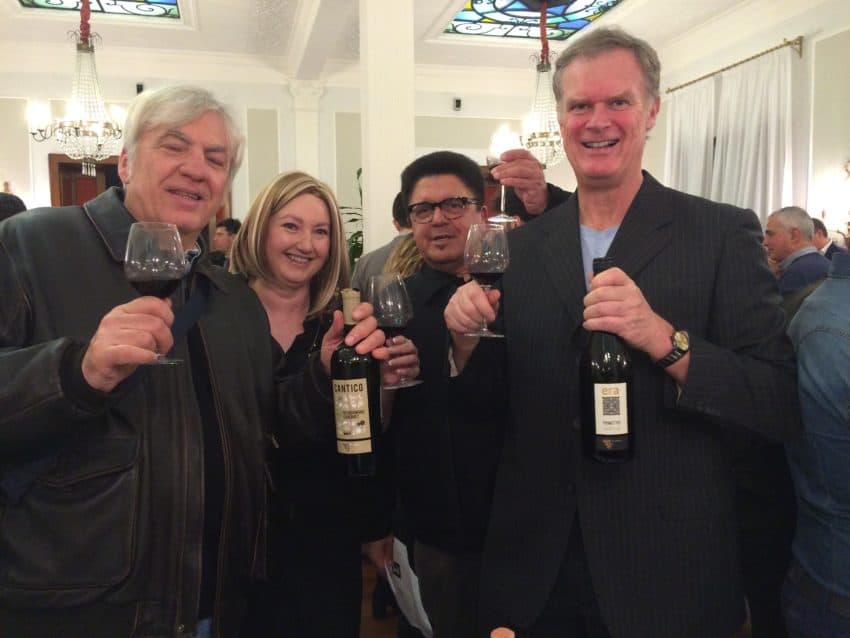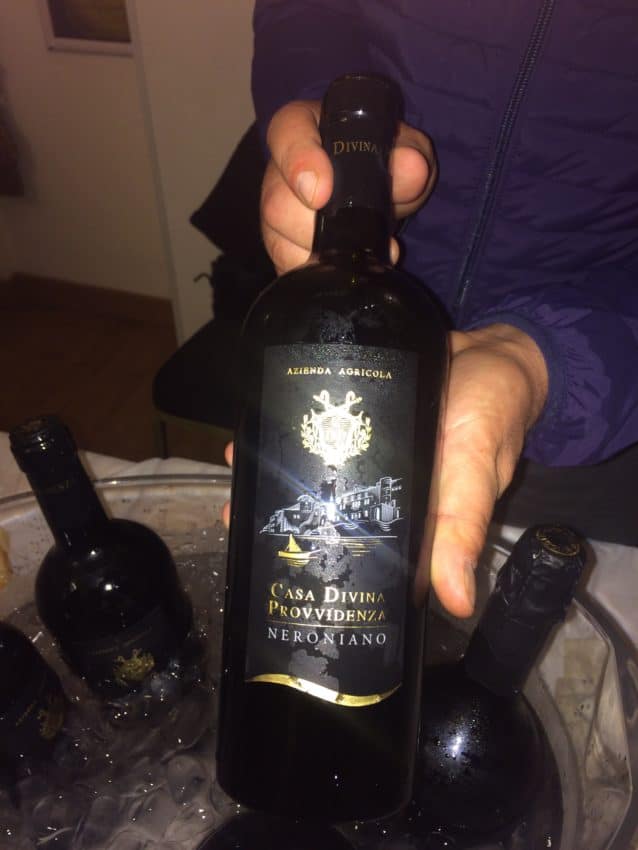Wine tastings in Rome a delicious way to travel around Italy without ever leaving the room

One of the first Italian words you must learn when you move to Rome is much harder to pronounce than “grazie,” “arrivederci” and “amore” but is just as important.
Degustazione.
That’s Italian for “wine tasting.” The degustazione (day-goose-stahtz-ee-OWN-aye) is a much bigger part of Rome’s nightlife than nightclubs. Rome is a sipping town, not a drinking town. There’s a difference. And there’s nothing more fun than sipping the best wines in the world, all in the same room.
This is important or all Rome visitors. Many land and scatter across Italy. They drive from winery to winery, with one eye on the GPS and the other on the rear-view mirror where the rapidly enlarging Fiat is about ready to blow their doors off.
Italy’s wineries are indeed beautiful. Sun-splashed vineyards sport vines lined up like green sentries. Patios overlook deep green valleys and hills. Tasting rooms look like lobbies of five-star hotels.

However, if you’re pressed for time and don’t want to hassle with a car, a necessity for wineries, you can stay in Rome and get an even bigger variety. In Italy, the wineries come to Rome. In my 3 ½ years here, I’ve been to countless degustazionies. I’ve tried superb wines from Sicily to Alto Adige.
I have been to only one winery: Terre dei Nappi in Umbria. It was part of my social circle’s Friends With No Benefits Tour. It was truly fun and authentic, a great cultural experience. But you just can’t pick up and go to Umbria every month. Every month, the whole country comes to Rome.
Rome has three main types of wine tastings, with dozens of options from all over the price scale:
One, food pairings. You stay in one place and drink a variety of wines, all with a carefully selected appetizer or cheese or meat, each one designed to bring the flavor out of the wine, and vice versa. Get Your Guide has one at a gourmet restaurant where three courses with four different wines is 88.00 euros. Get Your Guide also has a wine-and-cheese pairing in Palazzetto Giangiacomo for 35 euros. Rimessa Oscioli has a private tasting where patrons can choose from 2,800 different wines, 350 cheeses and 150 cured meats. Price 85 euros.
Two, tours. You can organize Tuscany tours from Rome but many tours here don’t leave the city limits. Viator lists a Campo Manzo and Jewish Ghetto tour where you visit different restaurants, each offering a different wine and food, for 98 euros. A walking tour with wine and appetizers is run by Best of Rome for 49 euros. Many tours go to Frascati, home of the popular fresh white wine made just 30 minutes south of Rome. Viator has a 3 ½-hour tour for 59 euros.

Three, tasting rooms. This is my favorite. Wineries from all over Italy come to a luxury hotel in Rome and set up a table. You pay a nominal fee, usually 15-20 euros and you can sample up to 30 wines without every leaving the room. Many come as themes. I’ve been to tastings for Puglia wines, volcanic wines, small-production wines. I went to a wine fair five minutes from my apartment in Testaccio.
Meetup groups are a great way to find wine tastings. I belong to Internations, the global monster that attracts hundreds of people in major cities all over the globe. Occasionally they do wine tastings. I’m also a member of the self-explanatory Wine Enthusiasts in Rome. I get notices at least three times a month about wine tastings just a bus ride, or short walk, away.
Last week I attended one organized by GoWine, an Italian wine promotion company out of Piedmont, in Northern Italy and my favorite wine region in the world. It billed the event as “Alla scoperta dei vini autoctoni italiani.” (Discover the Italian wines made from untransplanted vines — or something like that.) Anyway, the wines are made from vines cultivated in the same historic area as the origin of the vine. In other words, wine tastings in Italy get very specific.
It was held in the Hotel Savoy, a 200-year-old palace off tony Via Veneto where the paparazzi used to war with the many annoyed stars and starlets drinking wine on sidewalk tables. The hotel has a seventh-floor rooftop terrace with a lip-biting view of Centro Storico and the gargantuan Vittoriano monument in the same Piazza Venezia where Mussolini gave his balcony speeches. Nothing puts you in the mood to sip wine more than memories of fascism.

The wine tasting was held in three plain rooms on the lobby level. It’s a typical setup. The walls were lined with tables holding about a half dozen wine bottles for sampling. Each table had red and white, ranging in quality and price. A learned man or woman, either a sales rep or a sommelier, stands behind the desk and pours samples accompanied by an explanation.
I like going for many reasons. I like asking these wine experts one question, one of which I blogged about two years ago: If you were to be executed tomorrow, what’s the one wine in the world you’d drink tonight? I also find great unknown wines that I can find in my local enoteca, l’Oasi, which carries 1,500 labels. But the main reason is just a night of spectacular taste. These wineries do not bring any bottle that isn’t wonderful, that hasn’t received time-honored reviews. Each table is a new discovery. It’s a new destination, like an unexplored country that welcomes me with open arms.
As the big type on the program says, “BUONO … NON LO CONOSCEVO!” (GOOD … I DIDN’T KNOW IT!)
GoWine’s event had wines from 11 of Italy’s 20 regions, from Campania around Naples to Piedmont around Turin. A lot of these wines, let alone wineries, I’d never heard of. I first stopped at Buscareto, a small winery in Le Marche, which I’ve always labeled Tuscany light. It’s the region east of Tuscany with the same great hill towns, landscapes and wines as its more famous neighbor but at about half the cost. Buscareto had an incredible 2016 Verdicchio, famous in Le Marche, that retails for only 7-8 euros. I asked the goateed, friendly wine rep, Simone Saprati, about how a small winery makes it in the wine world of Italy. It’s like opening a pub in Dublin.
“We’re not so popular but we don’t like buses coming into the vineyards,” Saprati said. “We like cars and motorbikes.”
I tried Buscareto’s La Crima di Morro d’Alba. It sells for 7-9 euros. It’s very sweet on the nose — almost too sweet — but dry to the taste. A guy in his 30s saw me sniffing it. He pointed to the wine and said, “It’s great for ladies. Take her to dinner and give her this. She will fall in love.”
His name was Alex and is typical of Rome’s wine patrons. Young, successful, adventurous, liberal. He just returned from working three months in Honolulu making homemade pasta in an Italian restaurant. Romans come to wine tastings to taste wine, unlike in the U.S. where some come to show off their wine knowledge or, according to some American sommeliers, their ignorance. I heard one clown sniff a wine (scientists say 80 percent of all taste comes from what we smell) and tell the wine rep he smelled “a touch of mushroom.”
CHE CAZZO! (WHAT THE FUCK!) You didn’t smell “a touch of mushroom,” pal. But we all smelled a touch of arrogance.

Soon came Alessandro Castellani, my best Italian friend. He’s a sportswriter for ANSA, Italy’s wire service but he could be a food and wine guide anywhere in Italy. They are his passion and he can sniff out wine tastings before the ink is dry on the announcements.
We cruised around the room chatting with his old friends and new friends. It’s a very easy way to meet local Romans. You have so much in common: Rome. Wine. Curiosity. There isn’t the pretentiousness of other countries where wine is a perceived sign of social status and intelligence. In Italy, wine is one of the four major food groups. They’ve been drinking it since they were young at the dinner table. Wine is a time to share and savor. It’s not a time to impress.
We moved on to DonnaLia from Piedmont where the Barbera is the third most planted red grape in Italy behind Sangiovese and Montepulciano. DonaLia’s Barbera combines with Canavese, another Piedmont grape, to produce a strong, rich wine that’s a good, cheaper (at 15 euros) replacement for Barolo, my favorite wine and so tranquil it could end the war in Syria in about 10 days.
I found one desk not on the program list. The Cantina Frentana in Abruzzo had a fantastic Pecorino that is slowly becoming my favorite white wine. Price: 6.50 euros.

It’s important to take notes then take the notes to an enoteca and find a bottle for a very authentic Italian souvenir. You’re allowed to bring back two bottles for free. These degustazionies are fantastic places for research.
If you come to Rome, Google “degustazioni” and find a wine tasting that’s in town when you are. As an assist, here are three coming up in the near future:
Vino Roma’s My Italians, Tuesday, Wednesday, Friday, Saturday, Oct. 1, Via in Selci, 50 euros, 6 Italian wines with overview and tasting instruction: http://www.vinoroma.com/?p=19.
Tuscane Wine Tasting, Oct. 4, 7:30-11 p.m., EnoGallery, Via Urbana 131, 20 euros, two glasses and two food pairings: https://www.internations.org/activity-group/585/activity/227850?ref=cal_ac_li
Internations’ Gateway of Culture Home-Symposium: Triumph of Taste, Oct. 22, 4-9 p.m., Salone delle Fontane, Via Ciro il Grande 10-12, 20 euros, food and wine pairings:
http://www.internations.org/activity-group/10271/activity/227373?ref=cal_ac_li


September 25, 2017 @ 1:58 pm
Salve John.
Nothing to do with this blog, but have you been in Sicily this week? If not, then you and Marina have doubles and I have not embarrassed myself by going up and asking “Are you John Henderson?” To a strange man. Regards Geoff
September 26, 2017 @ 12:01 am
Ha! No, Geoff, I’ve been in Rome all month. I can’t believe there’s someone else who looks like me who “outkicked his coverage” with a woman who looks like Marina.